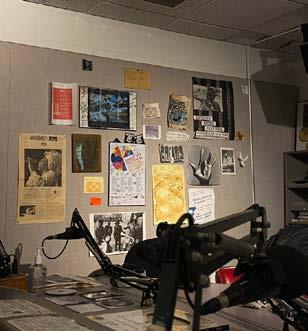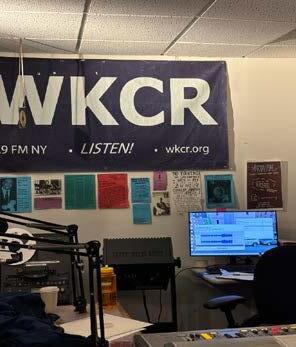
5 minute read
WKCR as Metaphor for Jazz
from OnAir April 2024
by wkcrfm
by Rachel Smith
In large part thanks to the legendary Phil Schaap, who hosted his first show on WKCR at 7:00 PM on February 2, 1970, WKCR is best known for its jazz programming. Though Schaap’s presence at the station was a turning point in WKCR’s history, our station’s jazz tradition started even before Phil and continues after him. Jazz is built into the very foundations of WKCR––through chance, invention, and passion.
Our station was founded on jazz. In 1933, the first U.S. patents for a wide-band FM radio system (which reduced static) were given to a Columbia University professor and electrical engineer by the name of Armstrong. Of course, his first name was Edwin, not Louis—though during Edwin Armstrong’s development of FM radio, Louis was indeed setting the world on fire with his trumpet. Professor Armstrong had an FM transmitter built in New Jersey and presented FM radio to the United States Federal Communications Commission in June 1936. He showed off his invention by playing music through an AM transmitter and then switching to his FM transmitter. As luck would have it, he chose to play a jazz record (though the identity of the record is lost to history). That’s right: jazz was the very first thing ever played on FM radio. With that historic broadcast, Armstrong brought the music closer to the engineers: “If the audience of 500 engineers had shut their eyes they would have believed the jazz band was in the same room” (San Bernardino Sun, Volume 42, June 18, 1936).

But our FM transmitter isn’t the only part of WKCR with a connection to jazz. Jazz strikes a perfect balance between tradition and innovation. Any jazz musician (I’ve got Matthew Shipp on my mind since he spoke live on the air on March 21st) will tell you this: “I had to learn the lineage, but then I had to do my own thing.” Jazz has such a rich tradition that every one of its musicians inherits; at the same time, jazz has never been about doing what’s been done before—it is constantly evolving. This applies, of course, to more than just jazz––Barry Harris, for example, used to say that if classical composers were alive today, they wouldn’t still be playing the classical works they had composed. They’d be innovating and improvising. I’ve paraphrased from what was relayed to me by his apprentice and partner, Howard Rees. But, for jazz more so than other genres, reinvention is part of its identity. Take avant-garde jazz, for example. “Avantgarde” means experimental or new; in a wonderful paradox, jazz boasts an avant-garde tradition.
WKCR embraces both tradition and innovation. These two concepts structure our programs: we air Phil Schaap’s incredible Birdflight and Traditions in Swing broadcasts; as we do so, we dedicate our new show, Now’s the Time (named for the Charlie Parker tune, in deference to Phil’s love for Bird), to the latest arrivals on the New York City jazz scene. Bookended in music history by these two shows, every week, we draw from over a century’s worth of music.

Jazz has never cared for boundaries, and neither do we. We play commercially released music and music that was never released, notably on Mitch Goldman’s biweekly Deep Focus podcast. We play recorded music and invite emerging artists to play live. We play jazz all-stars and relative unknowns. Perhaps most notably in this digital age, we play 78s (thank you, Matthew Rivera), LPs, EPs, CDs, and music we access online. We even have reel-to-reel tapes in our library. Because of WKCR’s commitment to preserving analog formats, WKCR’s studios house quite a few pieces of old technology. On the one hand, this puts us constantly at risk of having something break down (and not being able to get spare parts because the company went out of business before we were born). On the other hand, there’s something romantic about the lack of change—it connects us to a long tradition of jazz listening. We listen to music the way generations before us did. And not only generations of music lovers, but also generations of WKCR hosts. When I talk into the host microphone during one of my shows, I see around me what Phil once saw around him. Across from that mic is a red chair, once sat on by the likes of Duke Ellington and Dizzy Gillespie; today, any guest musician can sit where those greats once did.
Once upon a time, jazz was synonymous with popular music. It’s not that way anymore, which presents another way in which WKCR resembles jazz itself: once financially comfortable, we cannot take our preservation as a given. Keeping the past alive and forging into the future is difficult work––but for WKCR’s hosts, it’s a labor of love. We are honored to be on the air for 24 hours a day, 7 days a week, 365 days a year, bringing you great music that you wouldn’t hear anywhere else.

